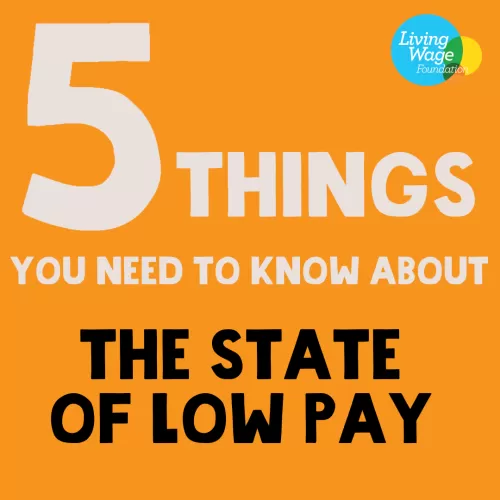Everyone needs a decent standard of living in order to thrive, but low pay remains a significant issue across the UK. The ongoing cost-of-living crisis has brought into sharp focus the vulnerability of low paid workers who were already struggling on tight budgets, and who are at the sharp end of the crisis.
This is clear from our latest report ‘Employee Jobs Paid Below the Real Living Wage 2023’ which was released last week and examines the scale and breadth of jobs paid below the real Living Wage in the UK. Read on to find out the five key things you need to know about the current state of low pay in the UK.

- 3.7M jobs in the UK were still paid below the real Living Wage in 2023 (1 in 8 jobs).
Our analysis found that 12.9% of employee jobs in the UK (3.7 million jobs, or 1 in 8 jobs) were paid below the Living Wage in April 2023 – an increase from 12.3% (3.5 million jobs) in April 2022.
- 15.4% of jobs held by women were paid below the real Living Wage, compared to 10.4% of jobs held by men.
Women were more likely to be paid less than the Living Wage compared to men, and jobs held by women accounted for 59.5% of all jobs paid below the Living Wage, 2.2 million jobs in total.
Working part-time also has a close link with low pay. A much higher proportion of part-time jobs were paid below the real Living Wage than full-time jobs in April 2023 – 28.3% of part-time jobs compared to 7.5% of full-time jobs.
39.2% of all employee jobs paid below the Living Wage in April 2023 were part-time jobs held by women, which shows that these workers are still over-represented in low paid jobs.
- Hospitality had the highest rate of low pay, with nearly half (48.1%) of all jobs in the sector paid below the real Living Wage.
This is the 12th consecutive year that hospitality has been the sector with the highest proportion of low paid jobs. Other sectors with above-average levels of low pay in 2023 include the arts, with 24.7% of jobs below the Living Wage and retail with 23.2% of jobs below the Living Wage.
- The retail sector had the highest number of jobs paid below the real Living Wage (818,000 jobs).
The retail sector employs many more people than the hospitality sector in the UK, so despite having a lower proportion of low paid workers, the number of low paid workers in the retail sector is higher than in the hospitality sector.
- North East England had the highest rate of low pay of any region, with 1 in 6 jobs (15.9%) paid below the real Living Wage.
It’s followed closely by the East Midlands at 15.7% and Northern Ireland at 15.6%. In contrast, the regions with below average levels of low pay in April 2023 were Scotland (10.1%), the South East (10.1%), the South West (11.8%) and the East of England (12.0%).
London has had a higher-than-average rate of low pay (13.3%) for the past two years. This is despite having previously been amongst the lowest impacted regions and having the highest average salaries in the UK. This is because Londoners have not felt the benefit from the increase to the government minimum and its associated ripple effects further up the income distribution. This is because unlike the London Living Wage, there is no separate legal minimum wage for London despite higher costs of living in the capital.
Want to find out more about this research? Read the full report here.
The real Living Wage is the only UK wage rate calculated on what it costs to live. In April 2023, the real Living Wage was set at £11.95 in London and £10.90 for the rest of the UK. The real Living Wage is currently set at £13.15 an hour in London (to reflect the higher cost of living in the capital) and £12 an hour for the rest of the UK.
In 2023 the number of businesses becoming accredited as Living Wage employers reached 14,000, with over 3,000 accreditations and 64,000 uplifts in 2023. Since 2011, 460,000 employees throughout the UK have been uplifted onto the real Living Wage through accreditation, which represents over £3 billion back into the pockets of low paid workers.
Join the movement and sign up as a Living Wage Employer today: Accredit | Living Wage Foundation.
